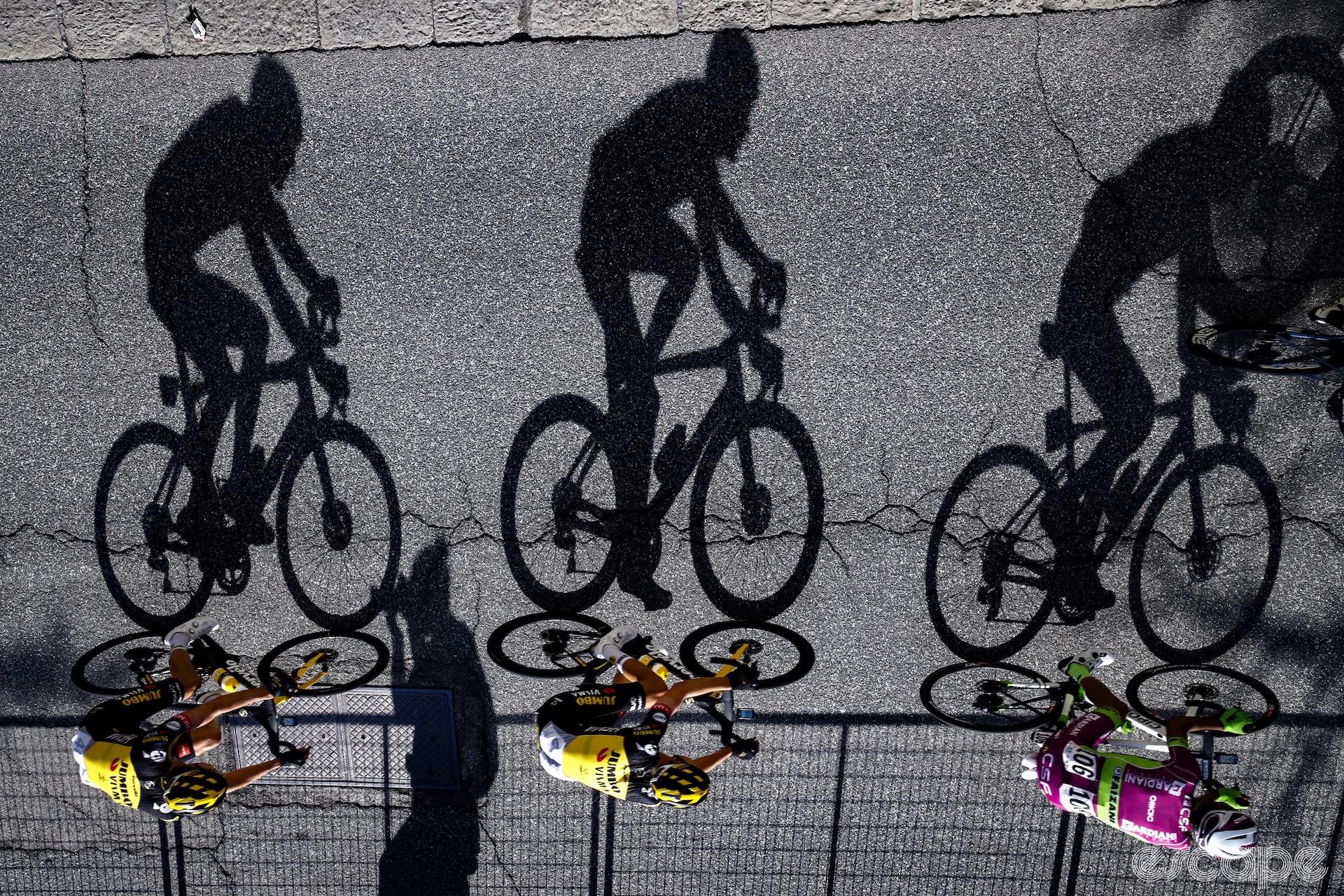Elite road cycling has an uncomfortable relationship with the issue of rider weight. For any rider hoping to perform well when the road is anything but flat, maintaining a low weight – and a high power-to-weight ratio – is critical. But the sport’s institutionalised desire for leanness has obvious downsides, with many riders developing unhealthy relationships with food if not diagnosable eating disorders.
Some new, preliminary research out of Switzerland appears to confirm a concerning trend in this regard: the relative weight of the top, male Grand Tour riders has been declining in recent decades.
In a study that’s currently undergoing peer review, a group of five researchers from the University of Bern and the University of Zurich looked at the height and weight of the top-five finishers from all men’s Giri d’Italia, Tours de France, and Vueltas a España between 1992 and 2022. In total, they considered a total of 445 height and weight combinations from 156 unique riders.
For each rider, they then used those height and weight measurements to calculate the rider’s body mass index (BMI) – a common measure of an individual’s weight relative to their height, determined by dividing an individual’s mass in kilograms by their height in metres, squared.
For context, the World Health Organisation considers an adult BMI of less than 18.5 to be underweight, anything between 18.5 and 25 to be “normal”, 25 to 30 to be overweight, and anything higher than 30 obese.
The researchers’ main finding: the average BMI of a men’s Grand Tour top-five finisher has dropped from 22.12 in 1992 to 20.13 in 2022.
Previous research had established that lower BMIs are associated with the top positions in men’s Grand Tours, but this study shows the downward trend of those average BMI figures. While average BMIs for the Grand Tours over the past 20 years – 20.76 in the Giro d’Italia, 20.80 in the Tour de France, and 20.42 in the Vuelta a España – “do not meet severity criteria” for eating disorders (according to the DSM-5, the industry-leading Diagnostic and Statistical Manual of Mental Disorders, Fifth Edition), the downward trend isn’t encouraging.
The quest for lower weight in elite cyclists has previously been linked with disordered eating, and mental conditions such as obsessive compulsive disorder, exercise addiction, and substance abuse. And if riders do manage to lose significant weight, low BMI is associated with increased risk of various medical conditions including depression, respiratory disease, hypothermia, osteoporosis, and more.
The researchers note that the apparent trend toward lower BMIs in the top Grand Tour riders is especially problematic when considering young, aspiring riders. Already there’s been some suggestion of disordered eating in the junior ranks and if the best riders in the world are getting leaner, it’s not hard to see young, impressionable riders following suit in increasingly unhealthy ways.
The researchers have some ideas about how to move the sport in the right direction, though. They encourage the UCI to consider “compulsory regular weight and body composition screenings for riders and mandating obligatory follow-up measures for athletes outside of a healthy range”, much as pro riders get heart scans every season.
They also suggest a “lower weight limit for riders in relation to their height using evidence-based recommendations”. The researchers point to the sport of Formula 1 where, in 2019, the regulatory body stipulated that drivers and their seat must weigh a combined minimum of 80 kg, to reduce the advantage of lighter drivers.
The researchers also point to a 2004 decision from the International Ski and Snowboard Federation to stipulate that ski length be determined by an athlete’s BMI, to mitigate the advantage lighter ski-jumpers get. Measures like this, and those in Formula 1, help to remove incentives for athletes to be as lean as possible.
Finally, the researchers suggest a need for “culturally tailored” education for those within the sport – riders and team support staff – to help untangle “entrenched sociocultural perspectives” about the desirability of low weight in elite cycling. The researchers suggest this could be part of the UCI’s new “health and wellbeing policy” that it has committed to in its 2030 Agenda .
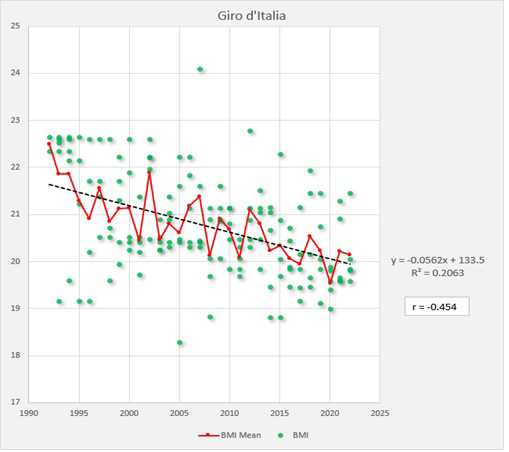
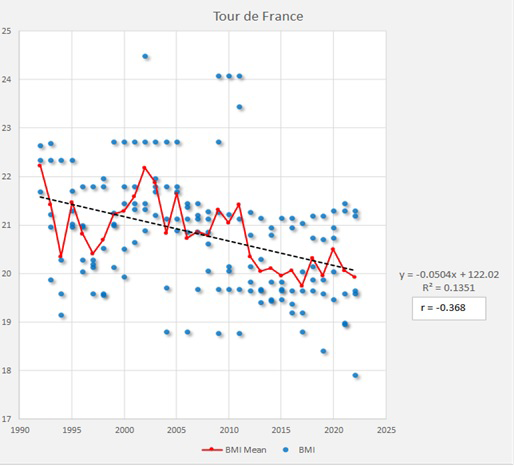
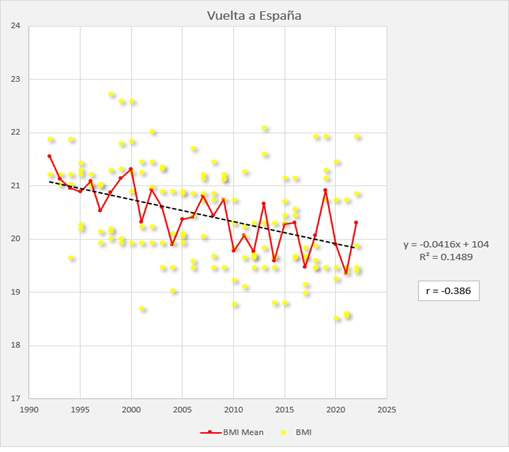
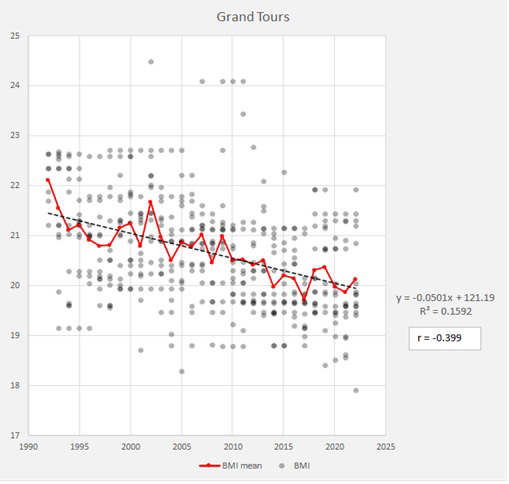
As with any academic research, this study should be viewed with a healthy amount of scepticism, particularly in a case like this where the paper is yet to be peer reviewed and published. Some basic errors in the draft study – Bradley Wiggins cited as the 2010 Giro d’Italia winner, say, or the Formula 1 driver-and-seat minimum cited as 18 kg rather than 80 kg – raise the possibility of other errors that aren’t so easily spotted by the lay audience.
The results section of the paper is very limited in its scope, showing only the average BMIs across the 30 years studied, rather than the trends from 1992 to 2022. Graphs in the appendices (reproduced above) show this trend but the actual numbers aren’t included.
The researchers also took height and weight data for their study from ProCyclingStats.com which, despite being the industry-leader in pro road racing statistics, is still a secondary source with incomplete information. For instance, height and weight data for 14 riders within the sample space are missing from the study because ProCyclingStats doesn’t have the relevant data.
BMI itself is a controversial metric, too. In both sporting and clinical applications, there are concerns that BMI is an overly reductive way of assessing leanness and one that doesn’t account for all body types or compositions. The researchers defend their use of BMI, though, saying its use is justified because BMI is “embedded within the DSM-5 as a severity marker for eating disorders.”
And finally, the study is somewhat narrow in scope. It only considered top-five finishers in the men’s Grand Tours, to the exclusion of all other places and races, and it excluded the women’s peloton entirely. The researchers note that longitudinal data of the kind found here is not yet available in the women’s peloton – the women’s Tour and Vuelta have only started in the past few years – but the Giro d’Italia Donne is a good candidate, having run almost-uninterrupted since 1988.
Caveats aside, this is an interesting piece of research that bears consideration. Road cycling has a difficult history with weight loss and if this paper is to be believed, that relationship is only becoming more problematic. It remains to be seen whether the BMIs of Grand Tour contenders will continue to drop, but even at the present levels, the UCI would do well to consider the recommendations made in this new study.
What did you think of this story?
